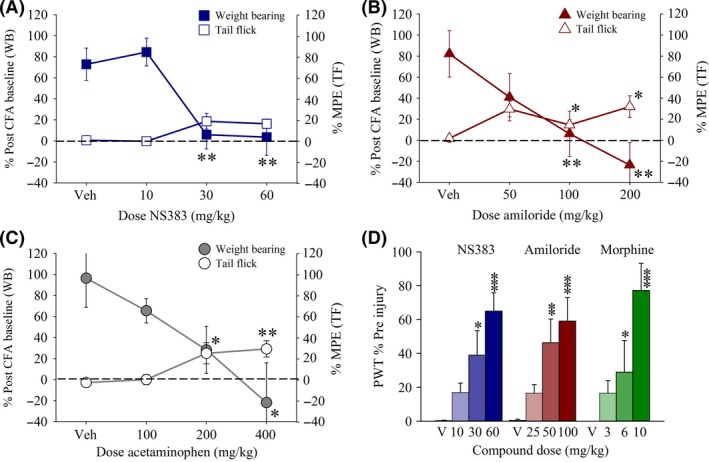Figure 5.

NS383 attenuates inflammatory hyperalgesia and neuropathic hypersensitivity in injured rats. (A–C) Prior to the establishment of hindpaw inflammation, the weight‐bearing difference (WB) and tail flick (TF) latency response was measured. Rats were then given a s.c. injection of complete Freund's adjuvant (CFA) into the hindpaw, and 24 h later post‐CFA, baseline responses were obtained. Thereafter, rats were administered either NS383 (10–60 mg/kg, i.p.), amiloride (50–200 mg/kg, i.p.), acetaminophen (100–400 mg/kg, i.p.) or vehicle and effects on weight bearing and tail flick responses expressed as a % post‐CFA baseline (WB) and %MPE (TF), respectively. The dashed line indicates the normalized WB response prior to CFA injection. All groups n = 7–8 rats. (D) Immediately after a second baseline response had been obtained, chronic constriction injury rats were administered either NS383 (10–60 mg/kg, i.p.; all groups n = 6 rats), amiloride (25–100 mg/kg, i.p.; all groups n = 8 rats), morphine (3–10 mg/kg, s.c.; all groups n = 6 rats), or vehicle (V; n = 6, 8, 6 rats for NS383, amiloride and morphine, respectively) and effects on threshold to mechanical stimulation of the injured hindpaw with von Frey filaments measured and expressed as % Pre‐injury. All data are presented as mean ± SE. *P < 0.05, **P < 0.01, ***P < 0.001 versus corresponding vehicle group (one‐way ANOVA followed by Bonferonni's test).
